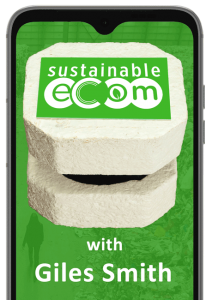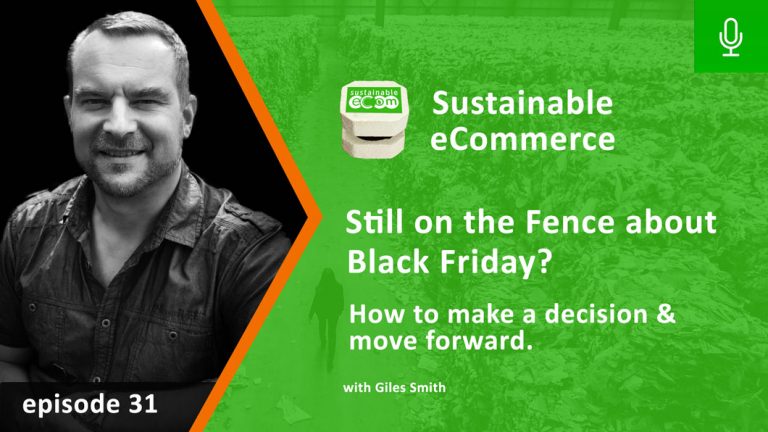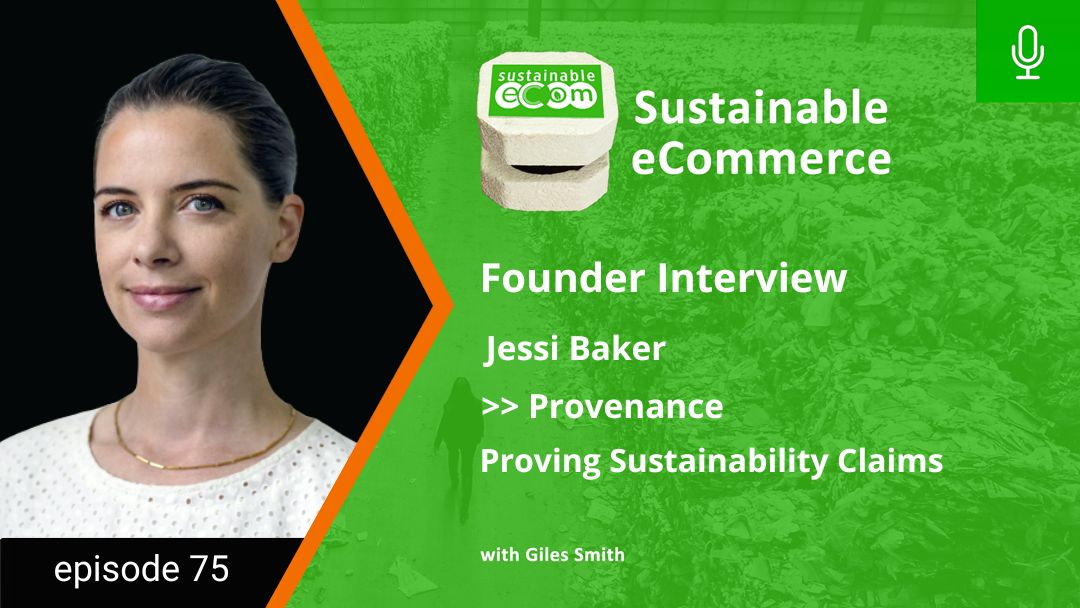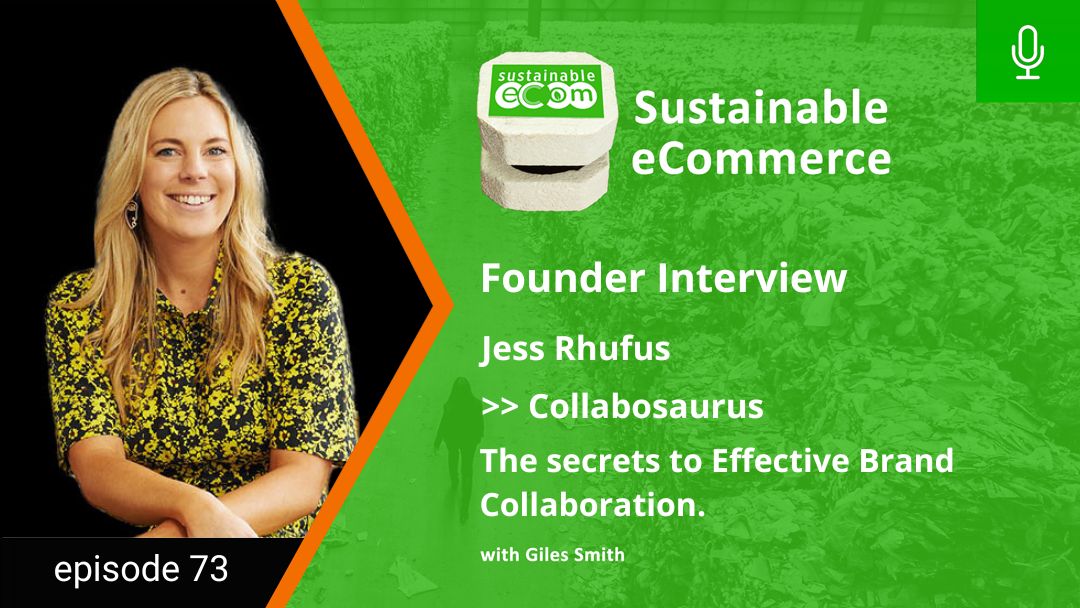Welcome to Episode 31 - How to Decide if Your Sustainable Brand Should Participate in Black Friday
We are now entering November, for most brands one of the biggest months of the year for ecommerce sales, with big events like Black Friday, Cyber Monday, not to mention Singles Day, Thanksgiving and so on.
Now, I hadn’t originally planned to do a show about Black Friday, because honestly how to smash it is covered in just about every other ecommerce podcast.
But just in various conversations over the past few weeks I’ve been quietly asking around among sustainable brand owners as to what they are doing for Black Friday this year.
I guess what I was expecting was a polarisation of views, from brands that have decided not to participate and are quite vocally against the event, and other brands who had a well thought through strategy for how to participate. What I really wanted to find out was why they have chosen one camp or the other.
Naturally I did find some of both, but what surprised me was the number of people who were still on the fence, who simply couldn’t decide what to do about it. Now there’s risk in either approach.
As we’ll discuss shortly there are potential brand congruency issues with taking part which could lead to brand damage. On the flip side, you risk losing the opportunity to acquire a flood of new customers, and potentially disappointing some people who were looking forward to purchasing from you during the event.
But in some ways, not making a decision is the worst of both worlds, & could lead to doubling that risk, especially if you leave it to the last minute to participate. That’s likely to result in an undercooked promotion, poor sales result AND questions raised about whether it matches your values.
So if you find yourself undecided, or if you’re yet to plan through what to do about the big events at the end of this month, this show is for you.
As you are no doubt aware, these mega hyped-up sales events, Black Friday in particular have been experiencing a fair bit of backlash of late. Critics point out things like the environmental damage the surge in sales creates. There are ethical questions around supporting hyper-consumerism and the unnecessary drain on resources from the hype causing consumers to purchase things they don’t really need. And we have the whole discourse around whether brands that give extremely deep discounts are operating ethical sourcing practices & offering fair pay through their supply chain. To be fair a lot of it is totally valid commentary.
Commentators on the subject like to make sweeping statements about a how these concerns are leading to a general decline in appetite for Black Friday sales among consumers. But the data doesn’t really support that at all. According to Nosto, 2021 Black Friday sales in Asia Pacific were up 17% in 2021, up 11% online, with average order value up 7%. In 2021, Australia Post reportedly delivered an incredible 800,000 parcels as a result of the Black Friday weekend, which was up 13% from 2020 and an eye watering 76% 2019.
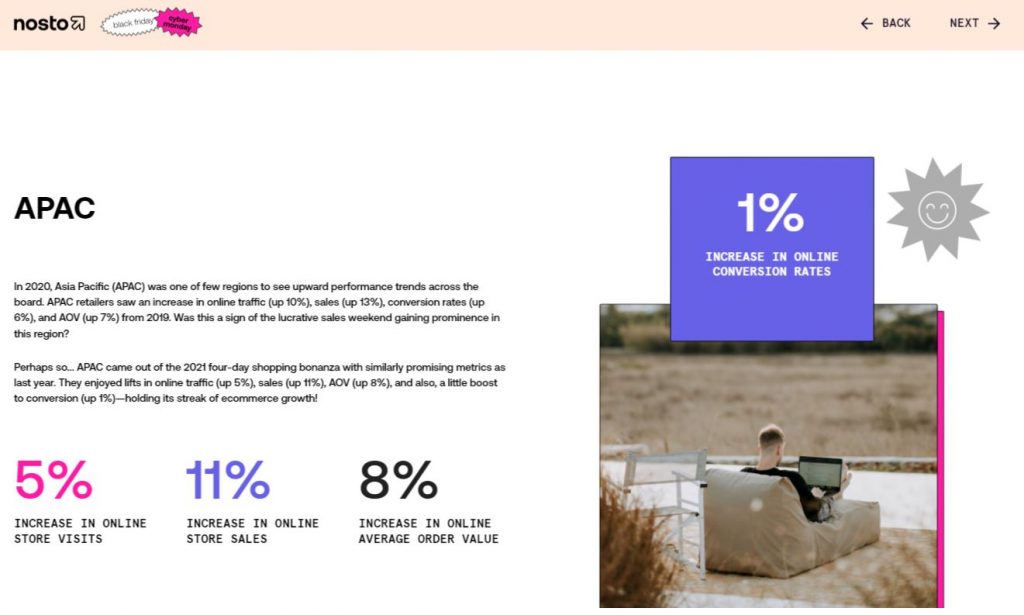
- My brand sells products that use sustainable materials. They are better for the planet than other products on the market, and we have made a concerted effort to reduce the environmental impact of our packaging.
- Statement two: My brand has a strong impact-driven purpose, and our customers enable that impact when they purchase from us.
- Statement Three: My brand takes a very conscious and ethical approach to sourcing, we ensure fair wages and provide employment opportunities to struggling communities.
So let’s come back to the discussion, and narrow in on what to do in your brand. One of the things you might be wrestling with in terms of participating in Black Friday might be the fear that as a sustainable brand, you shouldn’t be seen to be taking part, for ethical grounds. So let’s look at that through the lens of each of the above statements.
If your brand’s products leverage sustainable materials, and you’ve taken appropriate steps to minimize the footprint of your packaging, that means that your product is better for the environment than it’s non sustainable competitors. Whether we want it to or not, Black Friday is alive and well – which means consumers will be out there buying. I would rather you were out there competing for those sales and helping customers buy better. The more of your good product out there in use by consumers, the less bad product out there being bought by consumers. If that is the case, then the planet needs you brand out there on the field.
Moreover, the level of active eyeballs during the Black Friday period presents an ideal opportunity to be involved in the sustainability conversation, and to educate the customers. With the big picture in mind, I’m not sure that removing your brand from the conversation is an effective tactic. Sure, a few years ago some brands made waves by vocally not participating, even by shutting up shop completely. But that’s been done now. Unless your very dominant customer base is eco-warriors, this is unlikely to have a lasting impact. Have the morally profound efforts made a material impact on the momentum of Black Friday yet? The numbers don’t support that. By contrast, if sustainable brands withdraw from Black Friday, aren’t we just concentrating the non-sustainable alternatives?
Let’s turn to the second lens, where your brand generates impact as a direct result of customer sales. The more orders you take, the more impact you have. If you plant a tree with every order, that’s more trees planted. If you rescue a Koala with every order, that’s more endangered animals saved. If you provide stationery or support the schooling of kids below the poverty line, that’s more children you’ve helped. If every order goes to removing plastic from the ocean, that fewer bottles floating around. I think you get the idea.
If that sounds like your brand (and by the way, if you’ve implemented our Purpose Marketing Playbook – this definitely applies to you), then it seems to me a no brainer that you should take advantage of this heightened activity, and question changes from not whether you should, but how best to approach it. That’s especially the case when you come to look at how you structure your offers. Profit drives impact, and discounting is not a fine bedfellow of profitability.
If your brand follows the traditional view of bottom-line profit-based donations as your source of impact, deep discounting is almost directly at odds with your impact objectives. Structuring your deals appropriately, and even rethinking your past strategies entirely might be needed. This is so important that I’m going to come back to it shortly.
And now the third lens, that of ethical supply & social enterprises supporting struggling communities. In many ways my past discussion applies here too. I think it’s better for your brand to be actively involved in the conversation. If consumers are going to be buying anyway, doesn’t it make sense that you help them buy better and for a social cause? If your sales are supporting these communities, I would argue that you have a responsibility to do whatever you can to make sales & therefore take advantage of periods of higher demand.
Again, the real question focuses in on your approach to discounting. Certainly, you don’t want to be doing massively deep discounts, that’s definitely going to get you into questionable territory around ethical sourcing. This is most certainly true if your brand is in the sustainable fashion space – you’ll no doubt have a brand narrative against fast fashion, and so participating in such a frenzied sales event gets sticky.
So on the whole, unless your core narrative is slow fashion, I think there are plenty of arguments for participating in Black Friday. Can you still be involved in the conversation without deep discounts? I think you can and I’m going to come back to alternative approaches and deal structures shortly.
So at this point, if you see value in doing something for Black Friday, but it just isn’t sitting right, that’s OK. Make the decision now to not do it and shake of that nagging doubt. If it’s black Friday in particular that sticks in your craw, refer back to Episode 24 where we introduced Green Friday. That’s coming up on November 18th, and Peter Krideras & the team there are still accepting brands into the programme, but time really is running out, so take action. There’s also Giving Tuesday, which here in Australia is on November 29th. Can you do all of the events? Yes of course you can, and indeed that might be a great way to maintain momentum.
But if the discussion so far has motivated you to get involved with Black Friday, lets turn the discussion to how you can approach it.
Now first of all, lets quickly talk timing. Part of the ethical problem with Black Friday is the frenzy it creates, leading to people buying things they don’t need for fear of missing out on discounts. Many brands are turning to an extended sales period as a way of getting around that, often extending the sale for the whole month. Now obviously if you’ve been on the fence till now, you’ve missed the boat on the whole month, but you can still run your promotions for a week or more. In fact, its actually really effective to start as early as possible. You’ll find you can grab attention more easily outside of the big weekend, and collect that all important share of wallet ahead of your competitors. In past years when we’ve helped clients with Black Friday, we’ve seen 40-60% of their overall sales being pulled forward before the event itself.
Now the next thing to consider is branding the event, or invent a new day during this period that you can call your own? Citizen Wolf for example rebadge the day to Black Fridye – and promote people breathing new life into old clothes by dying them black. It’s a clever play on words, as well as being a message in line with their anti-fast fashion narrative. Branding the day can be particularly powerful if you’re running promotions attached to a specific cause. For example, if your brand’s mission is based around animal welfare, you could run a Black Doggie Day where 25% of your profits get donated to per rescue centres.
With that said, lets talk discount strategy. There’s no escaping the fact that buyer traffic and intent to purchase is elevated during this period principally because there are bargains to be had. But before you throw a dart at the board and slap on 40% storewide sale in the hope of attracting those buyers, let’s take a step back and consider your objectives. What does a good outcome from Black Friday actually look like for you?
Does your brand have a really good returning customer rate? And what I mean by that is, do they come back multiple times a year to purchase from you, either because you’re a niche brand with compelling cross sells, or perhaps you’re selling consumable products. If that’s the case, then it may well be worth going in hard on discounts, because your annual customer value will make that worthwhile. Acquiring customers is one of the most compelling benefits of Black Friday from a brands perspective, but deep discounts aren’t really going to help you if your customers only really buy once.
Are you seeing Black Friday as a way liquidate some slow-moving inventory? Perhaps you over purchased some SKUs a year ago and they’ve just not been selling. Better to get rid of them than having that cashflow locked up, and this might be the only other good reason to use deep discounts.
But just be careful with this as it’s a slightly dicey strategy. The fact that the product hasn’t been selling probably means that for whatever reason, it just wasn’t that desirable. A deep discount might change the value equation in your favour, but it also might just fall flat for compelling offers on more tempting options elsewhere. If that’s the case, your deep discount on the overstocked items makes any other offers look less compelling. Fine tuning it so that you’re running different offers on different days, and leaving the liquidation deal to later might be the way to go.
Now, it can be tempting to offer site-wide deals. That definitely makes it easy to understand for buyers, and it’s least work for you. It may not be the best outcome though. Site-wide discounts are often the cause of unexpected and most unwelcome margin erosion, especially if you end up with a lot of low cart-value purchases.
Lets work through that for a moment. Let’s say that you have an $80 item with a really healthy 75% margin, so it costs you $20 to make. And let’s say you make a full price sale from a Facebook with $20 cost per sale. That leaves you with $40 margin, 50% of the sale price.
Now let’s apply just a 20% site wide discount to that, with everything else the same. That’s a $16 saving to the customer, but that $16 directly reduces your gross margin from $40 to $24 – which is a 40% hit to you! And this is the peril of discounting! Maybe that doesn’t sound too bad, but what if Ad fees also go up around BFCM (which they will). What if lower margin products gets caught up in your site-wide offer? Suddenly, you can be left with wafer thin margins on which to repurchase your stock, or worse an unprofitable revenue spike.
It's far better to be more targeted with your offers. Pick specific high margin and higher dollar-value products to promote. Bundling and or offering bigger dollar-based discounts on high value carts can also be an awesome way to offer a great deal, but also make more margin. Let’s break that one down for a moment. Let’s say you upped the ante on a discount and offered $30 off orders over $150. That’s virtually double the dollar saving for the customer compared to our last example. Assuming again a 75% margin, your cost of goods will be $37.50, and if the ad CPS is the same at $20, now your margin on that sale is $62.50. That’s more than double your margin from your 20% offer. That also gives you a little more headroom for ad fee spike, and no risk of low margin products getting caught up in your offer.
Normal Order
Order Value: $80
COG: $20
Ad Cost: $20
Profit: $40
20% Store Discount
Order Value: $80
COG: $20
Ad Cost: $20
Discount: $16
Profit: $24
$30 Order Discount
Order Value: $150
COG: $37.50
Ad Cost: $20
Discount: $30
Profit: $62.5
Offers don’t have to only be about discounts though. Being a purpose-driven brand gives you a way to supercharge your deals without relying on deep discounts. Referring back to our second lens, where every order enables the customer to have a direct impact, it can be very effective to promote bigger impact-base offers. For example, if your brand plants trees with every order normally – could you amplify your offer by planting two trees? What would happen if you offered to plant 10 trees with every order – how could you make that work?
Impact-based offers can be very compelling. They’re a joy to promote and can give you a bit of good news PR, so if your brand leverages this style of order-based impact I do think it’s worth considering.
The key question to ask is would that be a compelling offer to attract customers. You really need to understand your customer base in order to answer that. Do they care about that impact outcome, will that motivate them to buy?
Another strategy that I’ve heard of being used is to actually increase your prices on Black Friday and use that increase for impact initiatives. Unfortunately, I don’t have any insight into how well that works, but my gut feel is not to do that, so let me explain why I think that.
Firstly we’ve already established that consumers are looking for deals during this period, so making your products less price-accessible, even if it is for a good cause seems counter-productive, except perhaps as a PR-piece. If your impact model is already order-driven, then rising prices also seems counter-intuitive – even if it’s only by $1, some people may get put off from purchasing, which is a drag on your impact not an enabler.
Lastly, I firmly believe that your core principle of being a purpose-driven brand is that you make it easy for the customer to have an impact. Making it more expensive so the customer pays for this impact explicitly seems like a friction point to me, and you’d be far better served using the amplification strategies we discussed a moment ago.
On balance, I do think that if you’ve chosen to participate in Black Friday, some element of discounting is probably necessary to connect with what customers are expecting.
So let’s turn our minds now to a quick set of other considerations you’ll need to work through to make sure your promotions deliver a great outcome. Obviously you’ll be looking at your email campaigns, social posting and any specific paid media for your offers, so I won’t beat the drum on that. But here are 6 things additional things I’ve found that often get overlooked with all the madness of just getting your deals and promotions together.
Check your stock levels. Hopefully you’re well stocked up for the Christmas period, but if you’ve been on the fence about Black Friday until now you may not have planned for that potential boost in sales. If you’re low on stock on great selling items, there’s no need to include those in your deals. They’ll probably increase sales with the extra traffic anyway.
Take a look at your site pop-ups and exit intents. It’s probably worth swapping them all out during your promotions for ones that makes sense with your main deals, even if that’s a specific Black Friday cart saver for people who don’t have the deal bundles in their cart, or to remind customers of the special deal if you have order-value based offers
It’s well worth setting up a specific deals page promoting what offers will be coming up, including a dedicated BFCM category page. You want to use the same one every year for SEO reasons, and you simply leave it there deactivated for the rest of the year.
If your main objective is to acquire customers, make sure your follow up is outstanding! The majority of people hunting for deals over the period will buy from multiple places, and so are even more likely to forget your brand unless you work hard to remind them.
If you’re running impact-amplification strategies, makes sure to congratulate them on helping with that initiative, make them feel like the hero. Follow up after the event and summarise what impact their purchase had, and what you’ve collectively accomplished.
Make sure your customer service team know the details of all deals & when they’re happening. That’s critical for things like phone and chat support where the answers need to be at their fingertips.
That’s again especially important if your offers are impact related, whether directly or through some specific donation fund. Make sure that your team understand these impact benefits, and are empowered to promote those benefits in all conversations with customers. That gives you a consistent brand message, hopefully converts some more sales, and maybe even helps to reduce refunds.
- And talking of your team, make sure your fulfilment partners understand what’s happening. You can be sure they’re going to be under pressure over this period, and other brands are likely to want additional support too. Especially if you’re running any unusual bundles, you need to take the time to provide clear instructions for how they need to be packed, any additional inserts etc that need to go in. Inserts can again be a great way to re-enforce your impact messaging – you really can’t say the same thing too many times when it comes to your mission!
Just to sum up today’s show, if you haven’t yet decided whether your brand should take part – commit to making that decision today, because time is very short. Don’t forget to register for Green Friday, even if you do also to BFCM and other branded promotions. If your brand falls into one or more of those categories mentioned earlier – sustainable products, order-driven impact, or social-good enterprise, then there are plenty of reasons why you should take part, and there are plenty of approached that allow your brand to be part of the conversation without resorting to a frenzied single day of deep discounts.
I hope that was useful. I’ll be back again next week with more stories from the world of SE, so until then, keep building your brand for a healthier planet!





